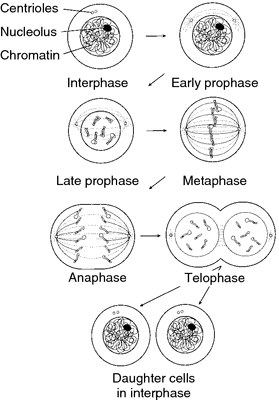mitosis
(redirected from Mitotic division)Also found in: Dictionary, Thesaurus, Encyclopedia.
mitosis
[mi-to´sis]During interphase the chromosomes are extended long threads that cannot be visibly identified. The DNA of the chromosomes is replicated during this phase, resulting in duplication of the genetic material.
During prophase the chromosomes coil up and contract, becoming short rods. Each chromosome consists of a pair of strands, called chromatids, held together at the centromere. At the same time the nuclear envelope disappears, and the centriole divides and the two daughter centrioles move toward opposite poles of the cell.
During metaphase the chromosomes move so that their centromeres are aligned in the equatorial plane of the cell (the metaphase plate), and the mitotic spindle forms. The mitotic spindle is formed of fibers composed of microtubules, which extend from the centrioles to the metaphase plate and to the centromeres of the chromosomes.
During anaphase the chromatids of each chromosome separate, becoming new daughter chromosomes, which are drawn to opposite poles of the cell by the spindle fibers.
During telophase the daughter chromosomes arrive at the poles of the cell, where they are surrounded by two new nuclear envelopes as they begin to uncoil and extend. During this phase, cytokinesis, division of the cytoplasm, occurs. A furrow forms around the cell in the equatorial plane and deepens until the two daughter cells are separated.
Originally, the term mitosis referred only to the division of the nucleus, which can occur without cytokinesis in certain fungi and in the fertilized eggs of insects. As used now, it usually refers to mitotic cell division.

mi·to·sis
, pl.mi·to·ses
(mī-tō'sis, -sēz),See also: cell cycle.
mitosis
(mī-tō′sĭs)mi·to·sis
, pl. mitoses (mī-tō'sis, -sēz)See also: cell cycle
Synonym(s): indirect nuclear division.
mitosis
(mi-to'sis) (mi-to'sez?) plural.mitoses [Gr. mitos, thread + -osis]Prophase: The chromatin granules of the nucleus stain more densely; the DNA strands coil extensively and become visible as chromosomes. These first appear as long filaments, each consisting of two identical chromatids, the result of DNA replication. Each pair of chromatids is joined at a region called the centromere, which may be central or toward one end. As prophase progresses, the chromosomes become shorter and more compact and stain densely. The nuclear membrane and the nucleoli disappear. At the same time, the centriole divides and the two daughter centrioles, each surrounded by a centrosphere, move to opposite poles of the cell. They are connected by fine protoplasmic fibrils, which form an achromatic spindle.
Metaphase: The chromosomes (paired chromatids) arrange themselves in an equatorial plane midway between the two centrioles.
Anaphase: The chromatids (now called daughter chromosomes) diverge and move toward their respective centrioles. The end of their migration marks the beginning of the next phase.
Telophase: The chromosomes at each pole of the spindle uncoil, the reverse of prophase, each becoming a long, loosely spiraled thread. The nuclear membrane re-forms and nucleoli reappear. Outlines of chromosomes disappear, and chromatin appears as granules scattered throughout the nucleus and connected by a lightly staining net. The cytoplasm divides (cytokinesis), resulting in two complete cells. This is accomplished in animal cells by constriction in the equatorial region; in plant cells, a cell plate develops in the same region and becomes the new cell wall. The period between two successive divisions is called interphase.
Mitosis is of particular significance in that genes are distributed equally to each daughter cell, and the diploid number of chromosomes is maintained in all somatic cells of an organism.
heterotypic mitosis
homeotypic mitosis
mitosis
The division of a cell nucleus to produce two daughter cells having identical genetic composition to the parent cell. First the long strands of CHROMATIN replicate and coil up to form dense chromosomes with the two copies (chromatids) joined at the CENTROMERE so that they appear X-shaped. At the same time, the envelope of the cell nucleus disrupts (prophase). Then two sets of strand-like microtubules (the spindle) appear, radiating from each end of the cell to the centre, the metaphase plate, and the chromosomes align themselves on the plate with the centromeres at the equator (metaphase). The copies of each chromosome (chromatids) now separate and move to opposite poles of the spindle (anaphase). Finally, the cell separates into two, the chromatin uncoils and the nuclear envelope of each reforms (telophase).mitosis
a type of nuclear division by which two daughter cells are produced from one parent cell, with no change in chromosome number. Mitosis is associated with asexual growth and repair and, although it is a continuous process, has been divided up into four main stages, given below. Further details of each stage can be obtained by referring to individual entries.- PROPHASE: chromosomes contract and become visible as threads. Each chromosome divides into two CHROMATIDS and the nuclear membrane disintegrates.
- METAPHASE: chromosomes migrate to the equator of a spindle and become attached to the spindle microtubes by their CENTROMERES.
- ANAPHASE: chromatids separate and go to opposite poles.
- TELOPHASE: nuclear membrane reforms, chromosomes lengthen and cannot be distinguished. See also MEIOSIS.
